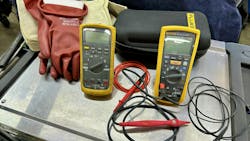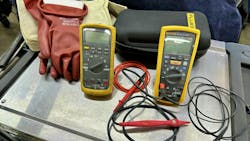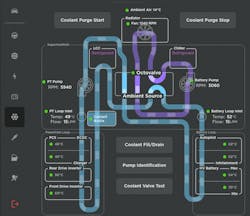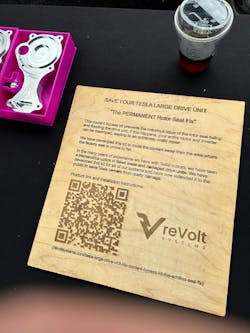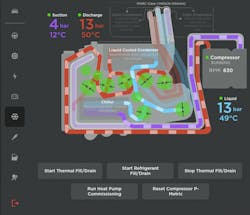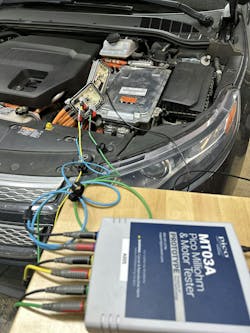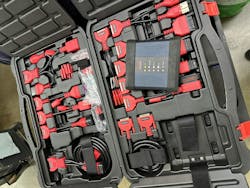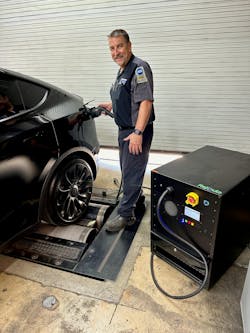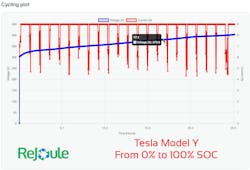The impact of electric vehicles on the automotive market
As you’re aware, the automotive fleet has been evolving with the rise of electric vehicles (EVs). For some states like California, this trend has been happening for some time at an accelerated rate. For those of us facing this technology change for the first time, it may be intimidating but it may also introduce several opportunities for automotive service professionals. Within this article, we’ll explore a wide list of considerations you can use to prepare for this new vehicle platform.
Understanding EV technology and maintenance
It’s true, EVs, with their simpler drivetrains, require a different maintenance program than what their ICE (internal combustion engine) counterparts require. When you break it down to their core components, the electric motor, battery pack, and power electronics make up most of the vehicle. However, there is going to be a different level of diagnostic information and procedures available both within service information (SI) and on the various vehicle data busses than what you’ve been dealing with in the past. For those who have been early adopters, engaging with hybrid vehicles from the past, the road ahead is less blurry. Although, for those just hopping on the bandwagon, you'll need to get up to speed and familiarize yourself with the diagnostics, maintenance, and repair of these systems. Battery health assessment, software updates, and electrical safety are key.
It has been my experience that EV owners are under the impression that the vehicle doesn’t require any maintenance at all, and this presents a major opportunity for the service market. Most owner’s manuals can be found online today through each vehicle manufacturer's website. I recommend that you study the maintenance requirements for the growing fleet in your location to get in front of what’s required. You can use this information to better inform your current and/or future clients about helping their vehicles operate properly.
For example, some vehicle manufacturers require the replacement of the desiccant bag within the refrigeration circuit at specific time intervals. Another tip I’d like to offer here is that you may want to peruse some of the online forums out there where many motorists hang out and discuss everything about these vehicles. You will be able to gather more intel about various pain points, misconceptions, etc., and use this information to help deliver a higher level of service to your clients.
Charging infrastructure and protocols
Possessing knowledge of various charging standards (Level 1, Level 2, DC Fast Charging, etc.) and their compatibility with different EVs is crucial for those delivering EV service. One of the bigger issues I see often is that for the most part, drivers don’t understand much on this topic which presents a great opportunity for educating them. Battery preconditioning for DC fast charging is one of the main issues that comes to mind. Many aren’t aware that the battery needs to be brought to a specific temperature range to fully optimize the proper DC fast charge rate. I have had many discussions with motorists at DC fast charging stations complaining about a slow charge. When I inquire about how they arrived, (typically through their navigation system) they reveal the failure point. For most EVs today, using the NAV will allow the vehicle to recognize the fact that the onboard systems need to prepare the battery for fast charging which often requires heating the battery coolant loop.
In my opinion, possessing knowledge of level 1 and 2 chargers today is essential to communicating and facilitating not only troubleshooting charging issues but also advising clients on what they need for home charging.
High-voltage safety
Working on EVs introduces the risk of high-voltage exposure. If you read any OEM service information, you’ll find statements about how technicians must be trained in high-voltage safety before commencing service on any HV systems. The training should also include proper use of personal protective equipment (PPE), dead-live-dead verification procedures, proper inspection of test equipment, proper handling of test equipment, isolation of electrical circuits, and emergency response to electrical incidents (Figure 1).
ASE has a new EV support system called xEV Safety Certifications. This statement comes from ASE's website (ase.com/ev) explaining the certifications:
“These ASE xEV High-Voltage Electrical Safety certifications were developed to serve as a guide, sharing existing industry standards, concepts, and practices followed by individuals working in the automotive, truck, and commercial electrical industry.”
On that page you’ll find that there are currently two levels of certification:
- xEV Electrical Safety Awareness Certification (Level 1)
- xEV Technician Electrical Safety Certification (Level 2)
I encourage you to research these and decide which one is best for you.
Regenerative braking systems, tires & alignment
Regenerative braking presents challenges as well. Understanding how these systems work and what drivers should consider can lead to overall better vehicle energy efficiency and extended tire wear. Tire wear on EVs is a major concern and consumers need to be aware of how to properly drive their vehicle by controlling torque in both acceleration and deceleration. Working the throttle properly can realize big gains in energy efficiency and tire wear. Some EVs have selectable screens to display the true application of torque which can be leveraged to obtain data feedback on pedal application. One of the other items I’ve discovered is that many vehicles leave the factory with the wheel alignment values not supporting optimum tire wear. Performing an alignment audit at the vehicle’s first tire rotation can help consumers get more life out of their tires. Additionally, tire technology continues to evolve and in fact, one tire manufacturer has gone “all-in” on developing an EV-specific tire. Hankook’s iON line of tires has many new attributes and features specifically aimed at conquering the main issues affecting tire wear, vehicle rolling resistance, NVH, and more.
Thermal management systems
EV battery performance and longevity are controlled through the battery management system (BMS) to help support optimum battery performance and life. Service personnel should possess knowledge of how important these systems are and their service requirements. Regular inspections of the thermal management components and fluid levels are important. If you ever find a low coolant level condition in a BEV, you need to resist the urge to top off the fluid because there could be an internal coolant loop leak. If this leak goes unchecked this could be very catastrophic for the vehicle. In fact, the large motor found on the early Tesla Model S and X vehicles has a design flaw where a leaking coolant seal within the drive unit can destroy the motor assembly (Figure 2). There are companies (Revolt Systems - revoltsystems.com/tesla-large-drive-unit-ldu-coolant-bypass-kit-the-achilles-seal-fix/) out there selling an inexpensive retrofit kit that will eliminate the possibility of this leak from occurring.
Thermal management relies heavily on the refrigeration system as well. This is something that should be inspected and serviced periodically. As mentioned earlier, some manufacturers have a replacement interval for the desiccant which requires a system recovery, evacuation, and recharge. These manufacturers are utilizing heat pump systems (Figure 3) because they can deliver thermal performance at greater efficiencies. Possessing a deep knowledge of the operation of heat pump systems is essential for proper system evaluation and service.
Software and firmware updates
Software Defined Vehicle (SDV) is a term you’ve likely heard, and this is how BEVs can improve their operation and performance. Tesla is one manufacturer that has proven how software updates can keep a vehicle’s operation, performance, and presentation fresh. I own a couple of Teslas and my six-year-old Model 3 has the same improved operational features found on current model year vehicles. Additionally, the service diagnostics available to the technician continue to improve and provide the service technician with great support tools all being delivered through the infotainment screen. Keeping the system up-to-date is important because the vehicle will be able to take advantage of the software engineering changes that support improved vehicle operation.
Customer education and support
This is a huge opportunity, maintaining a high level of awareness around EVs will allow you to communicate effectively and educate your clients. You may want to consider hosting educational events at your shop for consumers since this is a great way to build credibility for you and your brand.
Adapting service facilities
For the most part, many shops already have most of the tooling they need for basic EV maintenance. However, if you are planning to replace battery packs then you’ll likely need additional lifting and support devices. And in addition to the training mentioned earlier, you’ll likely want to invest in the proper measurement tools such as high voltage insulation testers (Figure 4), a milliohm meter, and scan tools with enhanced EV support such as the Autel EV Diagnostic Kit (Figure 5) which allows you to interrogate a battery pack without it being able to communicate with the vehicle — think sourcing used battery packs and how you can assess a used unit.
Market opportunities and challenges
In some regions of the country, there is a rapid growth of EVs which presents new business opportunities for automotive service professionals. Expanding services to include BEV maintenance and repair can open new revenue streams. Additionally, the used car market presents challenges such as the condition of the high voltage battery since it is the most significant and most expensive component to replace on BEVs today. Battery assessment is one of the biggest concerns consumers have when it comes to purchasing a used BEV. While some OEMs provide an indicator of battery state-of-health (SOH) through their BMS, the reading is often inaccurate. Companies are working on new tools, equipment, and software in pursuit of generating knowledge on battery assessment. The Autel EV Diagnostic Kit mentioned earlier provides a technician with a plethora of tools and battery assessment software for reading BMS data.
ReJoule (rejouleenergy.com) is a company that I have been working with in a pilot testing program where we are assessing battery SOH through a special DC charger which is performing a 10-minute advanced battery health check via a technique called Electrochemical Impedance Spectroscopy (EIS) testing (Figure 6). This EIS test can provide more accurate battery health readings that can then be used to optimize battery maintenance and replacement and provide transparency for used EV transactions. We are running a pilot data collection test by running characterization testing several dozen popular BEVs to assess battery health.
Conclusion
The alternative propulsion systems found in electric vehicles present challenges and opportunities. For those who have the right market, it may make sense to gear up and make the transition to support BEVs in your shop.
About the Author

Scott Brown
Founder - Diagnostic Network
Scott is an ASE Master Certified Automobile Technician with L1, L3, & L4 credentials and has over 39 years of professional service industry experience. As an independent shop owner in Southern California and with his engagement at various levels of within our industry, he continuously strives to move the industry forward through networking, education, communications, and training. Scott is a founder of the Diagnostic Network (https://diag.net/) which was born in 2018 after he retired after 22 years at iATN, where he served as company president.
Brown is also the host of Professional Tool and Equipment News (PTEN) and VehicleServicePros.com podcast, Torque Factor. The podcast addresses the latest automotive service technologies while focusing on expanding knowledge and awareness around tools, equipment, education, and industry trends.
